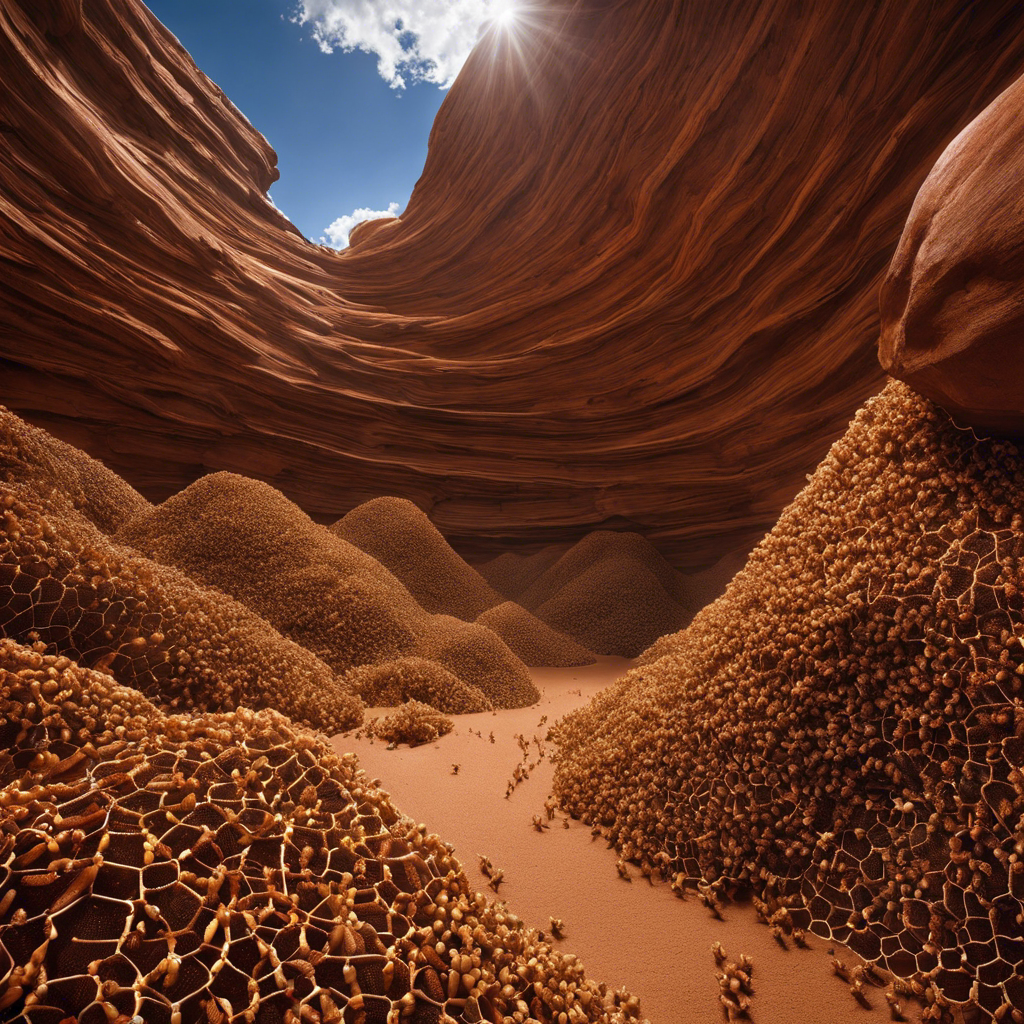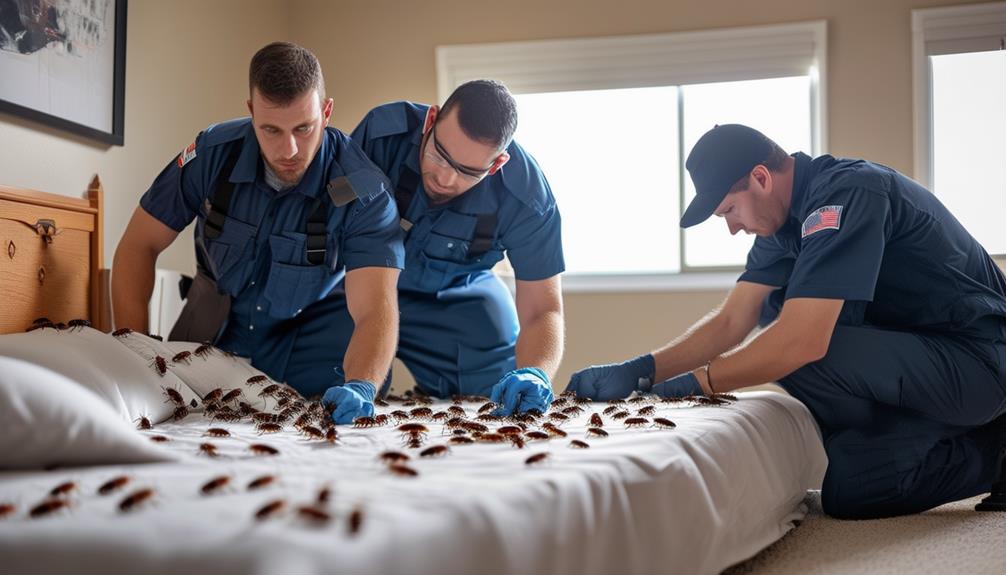Have you ever wondered about the intricate lives of ants in Utah? These tiny creatures, with their organized colonies and fascinating nesting habits, hold a world of mystery just beneath our feet.
From the resilient carpenter ants that thrive in decaying wood to the relentless pavement ants that invade our homes, each species has its own unique story to tell.
But what exactly drives these ants to construct such diverse nests and establish complex social structures?
Join us as we embark on a journey to uncover the hidden world of ants in Utah, where we will explore their nesting habits, unravel their colony dynamics, and gain a deeper understanding of these remarkable insects.
Key Takeaways
- Carpenter ants and harvester ants are the largest types of ants found in Utah.
- Pavement ants are the primary nuisance ants found in and around buildings in Utah.
- Pharaoh ants are commonly found indoors in Utah and can contaminate medical equipment.
- Velvety tree ants build nests in dead wood within trees and display aggression when threatened.
Carpenter Ants
Carpenter ants, the largest type of ant in Utah, are known for their black, brown, or red colors and distinctive striped pattern on their abdomen.
These ants have a preference for building their nests inside decaying, damp wood. Unlike termites, carpenter ants don’t eat the wood they nest in; instead, they scavenge for dead insects and honeydew.
They commonly live in colonies with a queen that lays eggs, but some also create secondary colonies without a queen or larvae.
Flood-damaged and decaying wood can attract carpenter ants indoors, so treatment often involves fogging the structure, applying crack/crevice spray, and spraying baseboards and the outside.
To prevent carpenter ants, it’s essential to keep wood piles elevated and away from the home, seal possible entry points at the base of the home, fix roof or pipe leaks promptly, and avoid wet or damaged wood in walls.
Harvester Ants
Harvester ants, known for their massive ant hills and intricate tunnel systems, are a species that establishes colonies in yards. These ants are the largest type of ant found in Utah, varying in size from 1/4 to 1/2 inches. They possess a unique characteristic of a two-segmented pedicel and spines on the midsection.
Harvester ants display a subtle striped pattern on their bodies, distinguishing them from other common types of ants. They primarily feed on gathered seeds, small insects, and arthropods. When threatened, they can be aggressive, delivering a painful bite and spraying secretions onto intruders.
Despite their aggressive nature, harvester ants aren’t frequent home invaders. In fact, they can benefit the soil by aerating it.
Pavement Ants
Pavement ants, characterized by their brown to black bodies and two-node waist, are the primary nuisance ants found in and around buildings in Utah. These ants are known for their uniform size, with workers governed by a single queen. Pavement ants have 12-segmented antennae equipped with a club, and their legs and antennae are lighter in color compared to their bodies.
They prefer sweet and greasy foods and often nest beneath rocks and in wall voids. Pavement ants build their nests near heat sources inside buildings and by sidewalks or rocks outside. They’re attracted to greasy, sweet, and starchy foods, as well as moisture. To prevent pavement ants, it’s recommended to use insect control sprays outdoors, clean up crumbs, and reduce areas where water collects.
Their nesting habits and foraging behavior can lead to structural damage in buildings. These ants thrive in sandy soil and can gain entry through small cracks and openings, making it important to seal potential entry points to keep them out.
Pharaoh Ants
Pharaoh ants, commonly found indoors in Utah, are a species of ant that range in size from 1/16-inch to 3/32-inch. These ants have a distinctive appearance, with body colors ranging from light yellow to red. They’re one of the most common ants found in Utah and are known for their preference to nest inside homes.
Unlike other ant species that build ant hills, Pharaoh ants tend to create their colonies within household structures. These ants have a broad diet, consuming everything from dead insects to grease and dog food. With colonies that can contain up to 300,000 workers and multiple queens, Pharaoh ants can pose problems by eating various foods and contaminating medical equipment in hospitals.
Velvety Tree Ants
Velvety Tree Ants, ranging in size from 1/10th to 1/4 inch, are known for their smooth and velvety dark abdomens. These ants play a crucial role in Utah’s ecosystem, building their nests in dead wood within trees, stumps, and logs. Their nesting habits contribute to the decomposition process, aiding in the recycling of organic matter.
Velvety Tree Ants have an omnivorous diet, feeding on insects, plants, honeydew, wood, and carrion. When threatened, these ants can display aggression, delivering a painful bite and spraying secretions onto intruders. To control their populations, bait stations can be used, targeting common household pests like Pharaoh ants and Thief ants.
Velvety Tree Ants are commonly found in Utah, with their workers ranging in color from brown to black.
Frequently Asked Questions
Does Utah Have Harvester Ants?
Yes, Utah has harvester ants. They play a crucial role in the ecosystem by dispersing seeds and aerating the soil. Their behavior patterns, impact on agriculture, and interactions with other ant species are important factors to consider.
Why Is There a Colony of Ants in My House?
Why are there ants in your house? Ants may infest your home due to the availability of food sources and suitable nesting locations. Effective ant control requires understanding their behavior, communication methods, and using extermination methods to prevent damage to your home.
What Are the Red Flying Ants in Utah?
The red flying ants in Utah are female and male reproductive ants. During their nuptial flight, they mate and establish new colonies. The males die after mating, while the females shed their wings and start new colonies, contributing to the ant life cycle.
Why Do Ants Gather Around?
Ants gather around for various reasons, including communication, foraging, nest construction, social structure, food preferences, defense mechanisms, reproductive strategies, impact on ecosystems, colony relocation, and interactions with other species.




